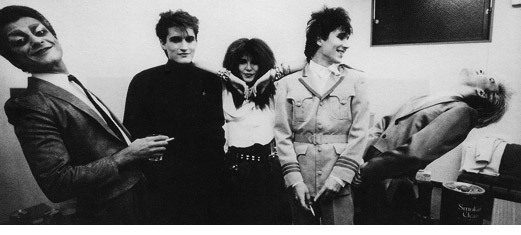
Sandii (center), backstage with Japan, 1982. Photo by Fin Costello.
Sandii & The Sunsetz
Sons of Pioneers Tour Opening Act
Though they garnered the most attention in the early 1980s under the name Sandii and The Sunsetz, this Japanese Pop band had already been recording together with similar lineups and under similar monikers for nearly a decade prior. Backed by band leader and guitarist Makoto Kubota, guitarist Kenichi Inoue, bassist King Champ Onzo and percussionist Hideo Inoura, and fronted by lead singer Sandii, born Sandy O'Neale, the band found moderate success throughout the 1980s 1.
The group's roots trace back to Jan Jan, a Shibuya club where Kubota, Onzo, Inoue and Inoura recorded their first album, 1973's "Sunset Gang," released under the name Makoto Kubota and The Sunset Gang 2. The following year, Sandii cut her first record in Hawaii, an EP on Pineapple Records titled "Sandy I," and she decided to return to her native Japan to pursue a career in the music industry 2. After returning to Japan, Sandii became friends with singer Kyu Sakamoto (known for his early 60s hit "Sukiyaki"), who helped her land a DJ job with public television broadcaster Nippon Hoso Kyokai (NHK) 3.
In 1975, under the name Sandy Ai, Sandii released a pair of 7" singles for Toho records. That same year, she met Makoto Kubota and The Sunset Gang when they appeared on her NHK television show to promote their album, "Hawaii Champroo" 2. Sandii hit it off with the group, who were already established enough to be supporting Eric Clapton on Japanese tour dates, and joined Kubota and The Sunset Gang as a back up singer 4. She continued to work on her own material, including the single "Goodbye Morning," which won the Grand Prix at the 7th World Popular Song Festival (Japanese equivalent to the Eurovision Song Contest) in 1976 5.
The group released their third album, "Dixie Fever," produced by Haruomi Hosono, in 1977 and they shortened their name to The Sunset Gang. 1978 saw the relase of "Mystery Nile," a collection of pop/disco covers, released under the name Sandy O'Neil. Though no credits are given in the liner notes, "Mystery Nile's" musicians include Sandii, Kubota and other members of The Sunset Gang 2.
After making a guest appearance on Yellow Magic Orchestra's 1979 LP "Solid State Survivor," Sandii began working with YMO's Haruomi Hosono, Yukihiro Takahashi and Ryuichi Sakamoto on her "debut" LP, 1980's "Eating Pleasure" 3. Hosono apparently convinced Sandii, who was still going by Sandy, to add the two i's to her name to reflect her Hawaiian influences 2. The Sunset Gang hopped on board the recording sessions of "Eating Pleasure," and thus Sandii and The Sunsetz was born. Lyricist Chris Mosdell, who previously wrote English language material for YMO, also worked on the album 5.
The group's first gig as Sandii and The Sunsetz was, rather amazingly, opening for YMO at the Budokan in 1980 6. They followed "Eating Pleasure," with another Hosono produced album, "Heat Scale," in 1981. During this time the band gained the attention of Japan, and Sandii and The Sunsetz were brought on as the opening act for Japan's Sons of Pioneers tour. Sandii and The Sunsetz got on well with Japan, and David Sylvian wrote material for and performed on their 1982 album, "Immigrants." "Immigrants" managed a fair deal of attention on its release, getting praise from Melody Maker, Steve Scales (of Talking Heads), Dave Jordan (of Fun Boy Three) and even David Bowie 1. The band followed up "Immigrants" with the 1982 single "Sticky Music," which reached number three on Austrailian charts 5.
David Sylvian's connection to The Sunsetz lasted through the mid 80s, and he wrote and sang on the track "This is Not Enogh," off of their 1986 album "La La La La Love" (released as "Banzai Baby" in the West). One of the stronger songs on the album, the track is an interesting counterpoint to the much more minimal material Sylvian was working on around that time.
Sandii and The Sunsetz delved into reggae territory for their final full albums, "Rhythm Chemistry" and "One Love," the former of which featured Sly Dunbar and Robbie Shakespeare. The Sunsetz split in 1990, leaving Sandii to further pursue her solo career and Makoto Kubota to focus attention on prodction work. Sandii began extensive study of Hula dance in the 90s and has since reached the rank of Kumu Hula (Hula Master) and owns a hula dance school 7.
Discography
Makoto Kubota & The Sunset Gang / The Sunset Gang
| 1973 | Sunset Gang | Trio Records |
| 1974 | Hawaii Champroo | Trio Records |
| 1977 | Dixie Fever | Trio Records (?) |
Sandy O'Neil
| 1978 | Mystery Nile | EMI Eastworld |
Sandii / Sunsetz / Sandii and The Sunsetz
| 1980 | Eating Pleasure | Alfa ALR 28002 |
| 1981 | Heat Scale | Alfa ALR 28022 |
| 1982 | Immigrants | YEN (Alfa) YLR 28004 |
| 1984 | Viva Lava Liva (compilation) | YEN (Alfa) YLR 28017 |
| 1986 | La La La La Love (AKA Banzai Baby) | Toshiba EMI WTP 90401 |
| 1987 | Rhythm Chemistry | Toshiba EMI CA32 1444 |
| 1988 | One Love | Toshiba EMI RT28 5248 |
| 1990 | Mercy (Sandii solo w/Makoto Kubota) | Toshiba EMI TOCT 5923 |
- "Sandii Solo Works / Sandii and The Sunsetz." Music Blog of Saltyka and His Friends. http://saltyka.blogspot.com/2007/11/sandii-solo-works-sandii-sunsetz.html.
- Kent, Nicholas & Rymer, Paul. "Sandii and The Sunsetz." Japanese Electronic Music. http://www.oceanofk.org/artskool/jem/ss.html.
- "Sandii and The Sunsetz." Wikipedia. http://en.wikipedia.org/wiki/Sandii_%26_the_Sunsetz.
- Clarke, Donald. "Sandii and The Sunsetz." MusicWeb Encyclopaedia of Popular Music. http://www.musicweb.uk.net/encyclopaedia/s/S14.HTM.
- "Sandii's Profile." Sandii's Web Club. http://www.h4.dion.ne.jp/~sandii/html/sindex0.htm.
- Cahoon, Keith. "Sandii and The Sunsetz - Profile." Nippop. http://nippop.com/artist/artist_id-27/artist_name-sandii___the_sunsetz.
- "Profile: Sandii." Sandii Official Site. http://www.sandii.info/vio/english.html.
«Return to connection










